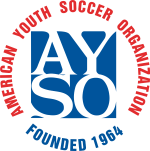Field Setup
Marking a New Playing Field
Chalk and paint are the quickest and easiest methods of marking a field, if the lines are not going to be permanent.
Equipment needed:
- One or two rolls of heavy twine — 100 yard minium
- Six or more rolls of plastic tent pegs, or 20d nails for harder ground
- Claw hammer
- One or two measuring tapes — 100-feet minimum
- One line marker — chalk or liquid
- Two bags of marking chalk (DO NOT USE LIME) per field or two cans of paint
- One or more assistants
Fields can vary in size but must be rectangular. Make the field as large as possible based on AYSO National Rules and Regulations for field dimensions. Sacrifice some length to obtain width, if necessary.
Field Dimensions from National Rules and Regulations
One Possible Marking method
Different people have different ways of marking. Below is one step. There are many websites that will give you full dimensions for marking fields. One example is here.
Step 1–Goal Lines Set the initial peg at one corner of the field to be built. Set the second peg three feet inward of the first peg along the intended goal line. Set the third peg four feet from the first peg along the intended touch line while measuring five feet from the third to the second peg to acquire a right angle. Example: Once the first corner has been established, repeat the process at the opposite end along the goal line. Remove the #2 pegs. Attach the twine between the two corner pegs, pulling it taut. Mark a chalk line along the twine. Do not remove the #3 pegs yet. Repeat the process at the opposite end of the field making sure the right angles at each corner line up. If you are in doubt, measure the distance from each corner to the opposite corner.
Step 2–Touch Lines Attach twine to number one pegs on opposite ends of the field along the intended touch line. The twine should fall exactly in line with the number three pegs. (If not, recheck measurement from corner to corner.) Pull the twine taut, lift and let fall to ground. This will allow for a straight line. Mark the complete side of the field with chalk or paint. Repeat on opposite side. Remove number three pegs leaving the corner pegs in place.
Step 3–Halfway Line Measure half the distance of the length of the field on each side and mark with a peg. Attach twine to those pegs and mark a line parallel to the goal line with chalk or paint. Remove pegs.
Step 4–Center Circle Measure half the width of the field at the halfway line and mark with peg. Attach twine to the peg and measure ten yards. With an assistant holding the twine taut at the ten yard mark, follow with the chalker or painter as the assistant walks the circle. If there is no assistant, tie the twine to the front of the chalker or painter and walk the circle, keeping the twine taut at all times so there are no “waves” in the circle line. Remove peg.
Step 5–Goal Area Measure half the width of the field at the goal line and insert peg. From this center point measure ten yards in both directions along the goal line and set a peg at each point. Measure six yards from the two outer pegs perpendicular to the goal line, using the same 3' x 4' x 5' method as for the corners, and insert pegs. Attach twine to each of the four pegs and mark with chalk or paint on the three sides of the goal area. Remove the outer pegs, leaving the center peg.
Step 6–Penalty Area From the center peg of the goal line, measure 22 yards toward each touch line and insert pegs. Measure 18 yards from each peg perpendicular to the goal line, using the 3' x 4' x 5' method and insert pegs. Attach twine to each of the four pegs and mark with chalk and paint, following twine. Remove outer pegs.
Step 7–Penalty Spot Measure 12 yards from the center peg of the goal line at right angles to the goal. Insert a peg and make a circle of nine inches. This may be a solid spot. Remove center peg.
Step 8–Penalty Arc Measure 10 yards from the center of the penalty spot. Attach twine to the peg. Following the procedure for the center circle, chalk or paint an arc outside the penalty area only, beginning and ending at the 18 yard line. Remove spot peg.
Step 9–Corner Areas At each corner of the field, mark with chalk a quarter circle with a radius of one yard, inside the field of play. Remove corner pegs. Optional marks may be made off the field of play 10 yards from the corner arc at right angles to the goal lines and touchlines to ensure defenders are far enough away from a corner kick.
Step 10–Coach’s area This is a rectangular area 2 yards deep and 20 yards wide set back at least 1 yard from the touchline and running parallel to the touchline. It is centered on the touchline so it extends 10 yards in each direction.
Step 11–Restraining Lines (optional) Where possible, these should not be less than 3 yards outside the playing field, parallel to the touch lines, the length of the field, from penalty area to penalty area. This allows the coaches and assistant referees ample space and prevents encroachments by spectators
Adjacent Fields If there is space for more than one field in an area, make them no closer than six feet when they are side by side nor twelve feet when they are end to end. Many Regions use one large field to make three smaller fields across for practice or small-sided matches.

